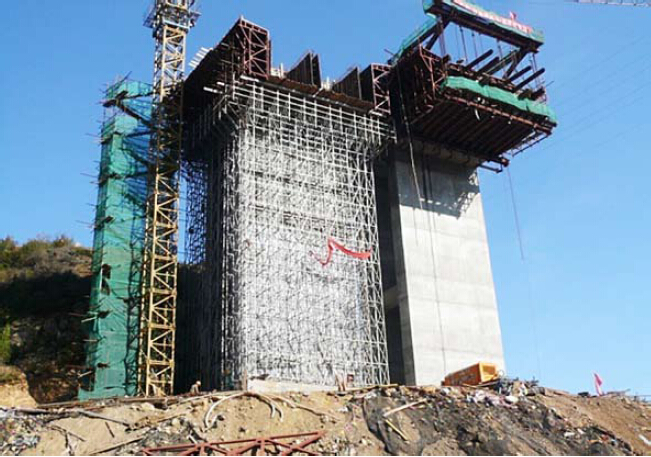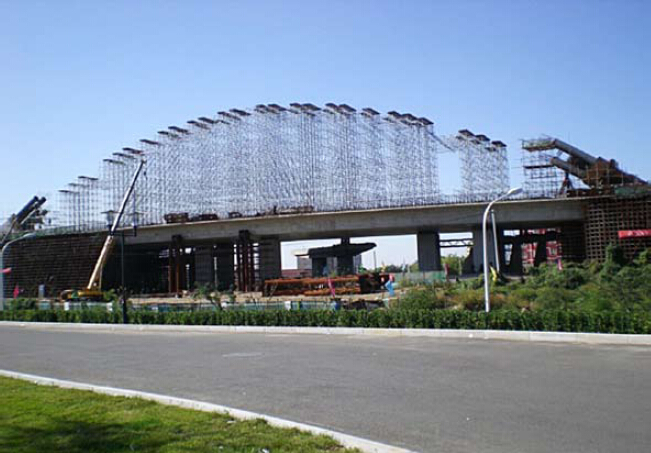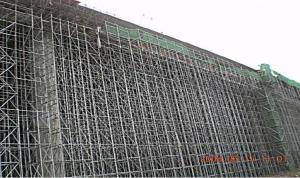Tower scaffolding for formwork and scaffolding systems
- Loading Port:
- Tianjin
- Payment Terms:
- TT OR LC
- Min Order Qty:
- 50 m²
- Supply Capability:
- 1000 m²/month
OKorder Service Pledge
Quality Product, Order Online Tracking, Timely Delivery
OKorder Financial Service
Credit Rating, Credit Services, Credit Purchasing
You Might Also Like
Tower Scaffolding
Shoring tower is an effective supporting system. It is easy to assemble and dismantlement, and
has excellent stability and bearing capacity. It has been widely used in the construction of industry
& residential buildings , bridges, tunnels and dam project, etc.
Characteristics:
◆ High degree of standardization.
◆ Easy storage and transportation


- Q:Can steel formwork be used for high-rise construction projects?
- Yes, steel formwork can be used for high-rise construction projects. Steel formwork is known for its strength and durability, making it suitable for heavy-duty applications such as high-rise construction. It provides excellent stability and support to the concrete during the pouring and curing process, ensuring the structural integrity of the building. Additionally, steel formwork can be easily assembled and disassembled, making it efficient for use in tall structures where multiple floors need to be constructed. Its reusable nature also allows for cost savings in the long run. Overall, steel formwork is a reliable and popular choice for high-rise construction projects.
- Q:Can steel formwork be used for residential tower construction projects?
- Yes, steel formwork can be used for residential tower construction projects. Steel formwork is a popular choice in the construction industry due to its durability and versatility. It is especially suitable for high-rise structures like residential towers, where the formwork needs to withstand high concrete pressures and provide a smooth finish. Steel formwork is known for its ability to be reused multiple times, making it a cost-effective option for large-scale projects. It can be easily assembled and disassembled, which allows for efficient construction schedules. Additionally, steel formwork provides excellent support during the pouring and setting of concrete, ensuring precise dimensions and alignment. Residential tower construction projects often require fast construction cycles, and steel formwork helps in achieving this by allowing for quick and efficient concrete pouring and formwork removal. The use of steel formwork also reduces the need for skilled labor, as it can be easily handled and manipulated. However, it is important to note that the specific requirements and design considerations of each residential tower project should be taken into account. Factors such as the height of the tower, load-bearing capacity, and architectural design may influence the suitability of steel formwork. Consulting with a structural engineer or construction professional is recommended to determine the most appropriate formwork system for a specific residential tower construction project.
- Q:Can steel formwork be easily disassembled and removed after construction?
- Certainly! After construction, it is possible to easily disassemble and remove steel formwork. These formwork systems are specifically designed to be reusable and offer great flexibility when it comes to assembly and disassembly. Typically, the components of steel formwork are lightweight, making them easily manageable and movable by construction workers. Furthermore, steel formwork systems often incorporate adjustable clamps and brackets, enabling swift and efficient dismantling. This not only saves time and labor costs but also permits the reuse of the formwork in future construction endeavors, making it an environmentally-friendly and cost-effective option for construction projects.
- Q:What are the different transportation and storage requirements for steel formwork?
- Steel formwork, being a heavy and durable material, requires specific transportation and storage requirements. For transportation, it is crucial to have suitable vehicles with sufficient carrying capacity to accommodate the weight of the steel formwork. Additionally, proper securing and fastening mechanisms should be employed to prevent any movement or damage during transportation. Regarding storage, steel formwork should be kept in a dry and well-ventilated area to prevent corrosion. It is essential to protect the steel formwork from exposure to moisture, extreme temperatures, and direct sunlight, as these factors can deteriorate its quality. Furthermore, proper stacking methods and supports should be utilized to prevent any deformation and ensure the longevity of the steel formwork.
- Q:How does steel formwork contribute to better site organization?
- Steel formwork contributes to better site organization by providing a durable and reusable system for creating concrete structures. Its accuracy, strength, and ease of assembly allow for efficient and precise construction, reducing the need for on-site adjustments or modifications. This results in a well-organized and streamlined construction process, saving time and resources. Additionally, steel formwork's versatility enables the creation of complex shapes and designs, enhancing the aesthetic appeal of the site.
- Q:How does steel formwork affect the overall speed of construction?
- The numerous advantages of steel formwork greatly contribute to the overall speed of construction. Firstly, its high durability ensures that it can withstand the pressure of concrete pouring without any deformation or damage. This durability allows for multiple reuses of the formwork, eliminating the need for constant replacement with new materials and saving both time and cost. Furthermore, steel formwork provides a smooth and even surface finish, which reduces the time needed for additional plastering or finishing work. This smooth finish also guarantees accurate alignment of structural elements, resulting in faster and more efficient construction. In addition, the ease of assembly and disassembly of steel formwork facilitates quick installation and removal. This user-friendly feature eliminates the need for extensive labor and minimizes the time required for formwork setup, ultimately accelerating the construction process. Moreover, steel formwork is highly adaptable and can be used in various types of building structures. Its flexibility allows for customization and efficient utilization in different construction projects, further enhancing the overall speed of construction. In conclusion, the utilization of steel formwork has a positive impact on the speed of construction by offering durability, a smooth finish, ease of assembly and disassembly, and adaptability. These advantages result in time and cost savings, efficient construction processes, and ultimately faster project completion.
- Q:What are the common cost-saving strategies when using steel formwork?
- Some common cost-saving strategies when using steel formwork include reusing the formwork for multiple projects, accurately measuring and cutting the formwork materials to minimize waste, properly maintaining and storing the formwork to prolong its lifespan, and utilizing innovative formwork systems that allow for faster installation and dismantling.
- Q:How does the cost of steel formwork compare to other types of formwork?
- The cost of steel formwork is generally higher compared to other types of formwork such as wood or plastic. This is primarily due to the higher material and manufacturing costs associated with steel. However, steel formwork offers several advantages such as durability, reusability, and greater load-bearing capacity, which can offset the higher initial cost in the long run.
- Q:How does steel formwork affect the overall sound insulation of a structure?
- Steel formwork has a significant impact on the overall sound insulation of a structure. Due to its dense and rigid nature, steel formwork tends to transmit sound vibrations more efficiently compared to other materials such as wood or plastic. This means that if steel formwork is used extensively in a building's construction, it can potentially reduce the sound insulation capabilities of the structure. The transmission of sound through steel formwork occurs mainly through three mechanisms: airborne sound, impact sound, and structure-borne sound. Airborne sound refers to sound waves traveling through the air and being transmitted through the steel formwork. Impact sound occurs when a sound wave hits the steel surface, causing it to vibrate and transmit the sound further. Structure-borne sound refers to vibrations traveling through the steel formwork and being transmitted to other parts of the building. To mitigate the negative impact of steel formwork on sound insulation, various measures can be taken. One approach is to use additional sound-absorbing materials, such as acoustic panels or insulation, on the interior surfaces of the structure. These materials can help reduce the transmission of airborne sound waves and dampen the vibrations caused by impact or structure-borne sound. Additionally, proper sealing and jointing of the formwork can minimize the leakage of sound through gaps or cracks. It is important to note that the overall sound insulation of a structure is not solely dependent on the formwork material. Other factors, such as the thickness of walls, type of insulation used, and the design of windows and doors, also play a crucial role. Therefore, while steel formwork may have a negative impact on sound insulation, it is possible to compensate for this by employing appropriate acoustic design strategies and incorporating soundproofing techniques throughout the building's construction process.
- Q:How does steel formwork affect the overall construction site logistics?
- The overall construction site logistics can be significantly impacted by steel formwork. Firstly, the durability and strength of steel formwork allow for multiple reuses, reducing the need for constant replacement and disposal of materials. This results in reduced waste generation and improved site cleanliness. Moreover, steel formwork is lightweight and easily adjustable, making it easier to handle and transport around the construction site. This improves material handling efficiency and reduces the time required for installation and removal of formwork. Additionally, the lightweight nature of steel formwork reduces the load on the structure, leading to reduced transportation costs and improved safety during construction. Furthermore, steel formwork offers high dimensional accuracy, ensuring precise and consistent shapes for concrete elements. This helps streamline the construction process by reducing the need for excessive adjustments and rework, resulting in improved time management and increased productivity. Additionally, steel formwork provides a smooth and even finish to concrete structures, eliminating the need for additional surface treatments and reducing the time and effort required for finishing work. In summary, steel formwork contributes to improved construction site logistics by reducing waste, enhancing material handling efficiency, improving construction speed, and ensuring high-quality finishes. Its durability, lightweight nature, and dimensional accuracy make it a valuable asset in optimizing construction processes and achieving project timelines more effectively.
1. Manufacturer Overview |
|
|---|---|
| Location | |
| Year Established | |
| Annual Output Value | |
| Main Markets | |
| Company Certifications | |
2. Manufacturer Certificates |
|
|---|---|
| a) Certification Name | |
| Range | |
| Reference | |
| Validity Period | |
3. Manufacturer Capability |
|
|---|---|
| a)Trade Capacity | |
| Nearest Port | |
| Export Percentage | |
| No.of Employees in Trade Department | |
| Language Spoken: | |
| b)Factory Information | |
| Factory Size: | |
| No. of Production Lines | |
| Contract Manufacturing | |
| Product Price Range | |
Send your message to us
Tower scaffolding for formwork and scaffolding systems
- Loading Port:
- Tianjin
- Payment Terms:
- TT OR LC
- Min Order Qty:
- 50 m²
- Supply Capability:
- 1000 m²/month
OKorder Service Pledge
Quality Product, Order Online Tracking, Timely Delivery
OKorder Financial Service
Credit Rating, Credit Services, Credit Purchasing
Similar products
New products
Hot products
Hot Searches
Related keywords






















